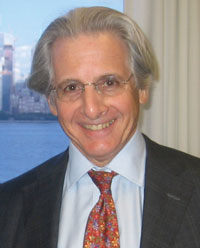 Now that the Federal Reserve has launched its third, open-ended, quantitative easing (QE3), investors need to consider the risks. Certainly Fed Chairman Ben Bernanke has. He outlined them recently at the Kansas City Fed's annual conclave in Jackson Hole, Wyo. There, in addition to providing considerable perspective on the extraordinary steps the Fed has taken since the 2008-2009 financial crisis, the chairman reviewed four critical risks involved in non-traditional policy tools and procedures. He probably could have added a fifth.
Now that the Federal Reserve has launched its third, open-ended, quantitative easing (QE3), investors need to consider the risks. Certainly Fed Chairman Ben Bernanke has. He outlined them recently at the Kansas City Fed's annual conclave in Jackson Hole, Wyo. There, in addition to providing considerable perspective on the extraordinary steps the Fed has taken since the 2008-2009 financial crisis, the chairman reviewed four critical risks involved in non-traditional policy tools and procedures. He probably could have added a fifth.
Bernanke's first concern has to do with liquidity. The massive size of the Fed's quantitative easings, he said, leads him to worry that the markets in which the Fed operates could take on an administered character. That quality could drive out private trading and, with it, the price discovery and liquidity on which markets rely. Bernanke went so far as to say that the lack of a “free-trading” aspect in Treasuries and agencies, to use his words, could erode the lead these markets have offered in pricing and yield, making overall financial markets less efficient as well as weakening the overall effect of future Fed policy moves.
A second concern involves confidence. The chairman worries that the expansion of the central bank's balance sheet will raise doubts about its ability to adjust monetary policy, in particular its ability to exit from its present, highly accommodative stance. Even if that concern is unjustified, Bernanke emphasized, such a loss of confidence could drive up long-term inflation expectations and thwart the Fed's otherwise carefully developed plans to “normalize monetary policy” at some future date. Sadly, he failed to review those plans.
Stability was third on the chairman's risk list. He worries that non-traditional policies, by driving down long-term yields on Treasuries, agencies, and mortgages, will induce investors to make an “imprudent reach for yield” that could in time produce losses and destabilize financial markets. Bernanke was quick to point out that the Fed saw no evidence of such a move as yet and would actually welcome more risk-taking by investors, at least within reasonable bounds. But he did recognize that the underlying risk exists.
The chairman's fourth and final concern dwelt on the potential for losses in the Fed's now immense security holdings. Since the Fed turns all its profits over to the U.S. Treasury, any such losses would effectively add to the government's budget deficit. Against this concern, Bernanke offered reassurance that the Fed's purchases actually benefit taxpayers by reducing the federal government's deficit and debt, presumably by holding down the cost of debt servicing. But he acknowledged that containing government debt is less important than the Fed's efforts to stimulate the economy and so the country's living standards.
These four concerns revolve around what Chairman Bernanke referred to as the Fed's “balance-sheet tools,” but the Fed's new “communications tools” raise a fifth and potentially serious risk. A great potential for heightened volatility lies in policy makers' new practice of expressing their longer-term expectations of where interest rates are headed. When the Fed makes an interest-rate forecast, it effectively invites all investors to position themselves in a consistent way. Though the Fed qualifies its expectations by explaining that they depend on unfolding economic and financial conditions, the fact is that the public pays scant attention to such qualifications and believes instead in the Fed's special insight and its power to enforce its expectations. As long as matters go as the Fed expects, this near-uniform positioning presents little risk. But if unforeseen events force the Fed to deviate from its stated plan, such common positioning will require the bulk of market participants to adjust, disrupting markets greatly and adding to volatility.
Of course, policy shifts have surprised markets and been disruptive in the past. But because the Fed previously kept its rate expectations to itself, market participants positioned themselves across a spectrum of possibilities. Some looked for rate increases, some decreases. Some looked for a move sooner, some later. When the Fed adjusted policy, only some market participants needed to adjust. Now, with the Fed offering official expectations, it would take a bold investor indeed to position himself or herself in any way other than what the Fed indicated. Any Fed deviation from its stated path would force a much greater proportion of the market than in the past to make portfolio adjustments, bringing on much more disruption and volatility. Unless Chairman Bernanke and his fellow monetary policy makers have acquired a God-like ability to see the future, this new communications tool could ultimately cause more harm than good.
Nothing in this discussion aims to criticize the Fed's extraordinary efforts to deal with the financial crisis and its aftermath. Even considering all the risks, it is hard to see what choice policy makers had in the extreme circumstances of 2008-2009 and have had in the difficult years since. But given these risks, it is also apparent that the jury is still out on the ultimate efficacy of these policies. By making his concerns public, Chairman Bernanke has offered a measure of reassurance that the Fed is at least aware of the potential side effects of its powerful policy medicine and stands ready to deal with them. Markets now must see if the Fed can and will execute on these comforting implicit promises.
© 2025 ALM Global, LLC, All Rights Reserved. Request academic re-use from www.copyright.com. All other uses, submit a request to [email protected]. For more information visit Asset & Logo Licensing.




